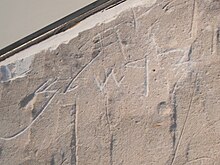
Khirbet Beit Lei graffiti

The Khirbet Beit Lei graffiti are seven inscriptions in Hebrew in various states of preservation found in the excavations at Khirbet Beit Lei.

Of particular interest is one inscription containing a very early appearance in Hebrew of the name ירשלם (Jerusalem).[1]

Interpretation
There is disagreement about how they should be read. It appears that the words YHWH (Yahweh) and YRŠLM (Jerusalem) feature in the inscriptions, which Joseph Naveh dated to the late 6th century BCE.[1][2]

Naveh read it as

יהוה אלהי כל הארץ הרי יהד לו לאלהי ירשלם
yhwh ʾlhy kl hʾrṣ hry yhd lw lʾlhy yršlm
which he translated as "Yahweh (is) the God of the whole earth; the mountains of Judah belong to him, to the God of Jerusalem".[1] An earlier example of the name appears in a papyrus from the 7th century BCE.[3][4]


Frank Moore Cross disagreed with many of Naveh's readings of the letters, instead interpreting the inscription as a poetic rubric in the first person: "I am Yahweh thy God: I will accept the cities of Judah, and will redeem Jerusalem".[5] Cross speculated that it was "the citation of a lost prophecy", perhaps written by a refugee fleeing the 587 BCE destruction of Jerusalem.[5] Naveh later dismissed Cross's reading and stuck to his own version.[6]

Other scholars, including Lemaire and Puech, have proposed additional readings. Patrick D. Miller read it almost the same as Cross did: "[I am] Yahweh your God. I will accept the cities of Judah. I will redeem Jerusalem."[7]

References
- ^ Patrich, Joseph; Tsafrir, Yoram (1992). E. Stern (ed.). האנצקלופדיה החדשה לחפירות ארכיאולוגיות בארץ ישראל [The New Encyclopedia of Archaeological Excavations in the Holy Land] (in Hebrew). Vol. I. pp. 181–186.
- ^ Ahituv, S., Klein, E. and Ganor, A. 2016. "To Jerusalem: A Seventh Century BCE Shipping Certificate." In: Stiebel, G.D., Uziel, J., Citryn-Silverman, K., Re’em, A. and Gadot, Y., eds. New Studies in the Archaeology of Jerusalem and Its Region 10: 239–251 (In Hebrew)
- ^ Cited by:Yuval Baruch, Danit Levi & Ronny Reich (2020). "The Name Jerusalem in a Late Second Temple Period Jewish Inscription". Tel Aviv. 47 (1): 108–118. doi:10.1080/03344355.2020.1707452. S2CID 219879544.
- ^ a b Frank Moore Cross (1970). "The cave inscriptions from Khirbet Beit Lei". Near Eastern archaeology in the twentieth century : essays in honor of Nelson Glueck. Doubleday. pp. 299–306.
- ^ Patrick D. Miller (2000). Israelite Religion and Biblical Theology: Collected Essays. Continuum. p. 222.
See what we do next...
OR
By submitting your email or phone number, you're giving mschf permission to send you email and/or recurring marketing texts. Data rates may apply. Text stop to cancel, help for help.
Success: You're subscribed now !

